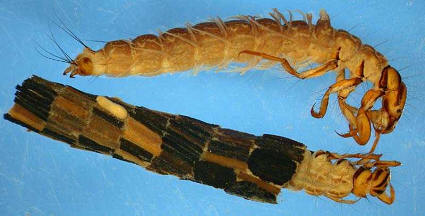
Nutrition
 Shovelnose sturgeon use their barbels to sense prey on the bottom of
rivers. Once they sense their prey they suck it up from the
substrate using their mouths. This hunting technique is successful for
shovelnose sturgeon because of their ability to hold their position in
highly turbid water. This allows them to have easy access to their with
very limited competition.
Shovelnose sturgeon use their barbels to sense prey on the bottom of
rivers. Once they sense their prey they suck it up from the
substrate using their mouths. This hunting technique is successful for
shovelnose sturgeon because of their ability to hold their position in
highly turbid water. This allows them to have easy access to their with
very limited competition.
Figure 5. Caddisfly larvae (trichoptera) by Jeff Shearer June 30, 2010.
The Shovelnose Sturgeon's main diet consists of tichoptera (Figure 1.), diptera, and ephemeroptera. Trichoptera are caddisfly larvae, ephemeroptera are mayfly larvae, and diptera are true flies. Its diet can also include mollusks and crustaceans. (Bock et al, 2011)
During the spring and the fall the trichoptera larva is what makes up most of there diet. During these months they usually take advantage of the waters current and eat prey as they drift by. The summer months are split into two stages early and late. During the early stage shovelnose sturgeon prefer chiromomids, but during the late stage it usually eats ephemeropterans. (Seibert et al, 2011)
back to Vulnerability or continue to Reproduction